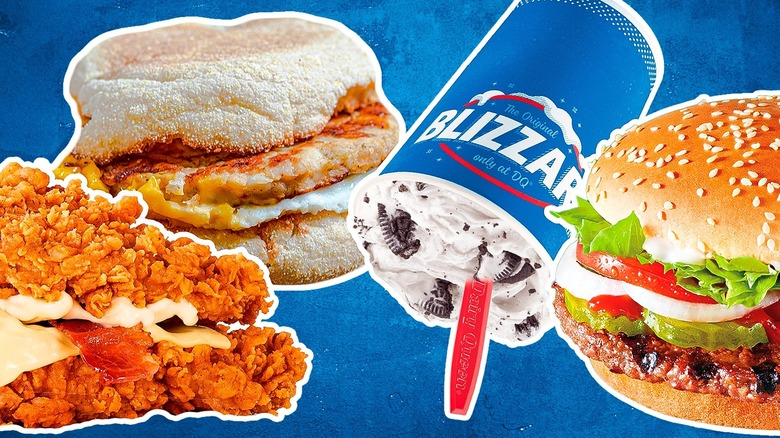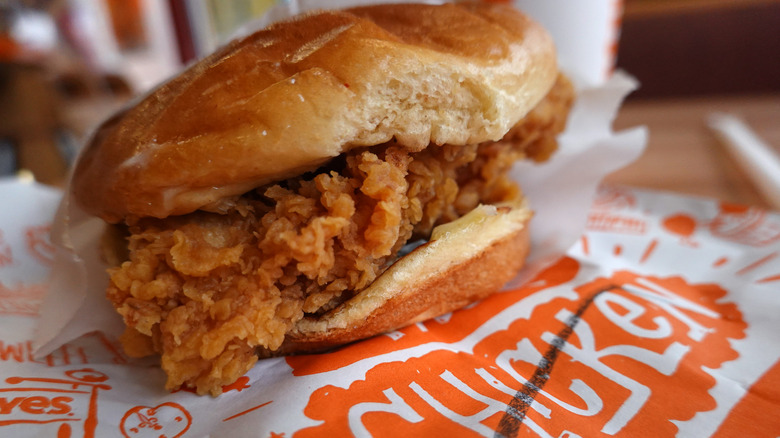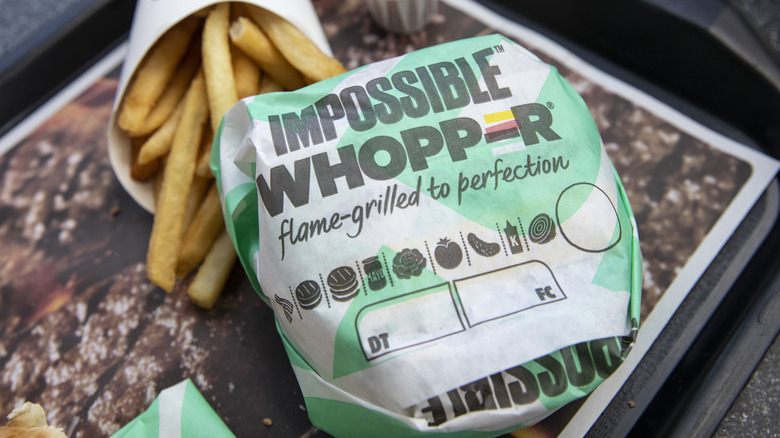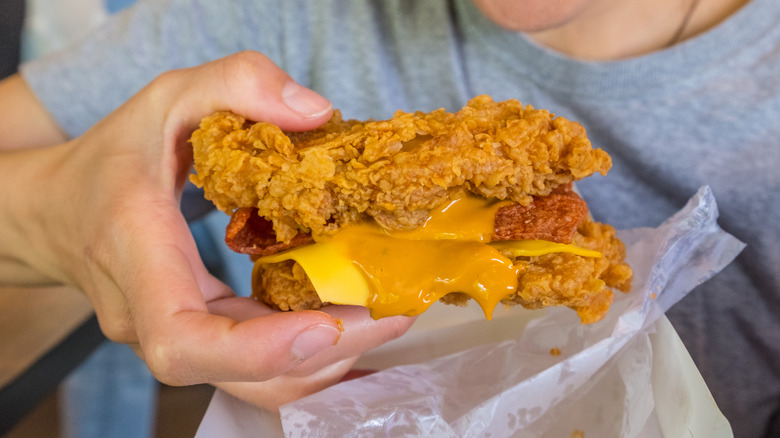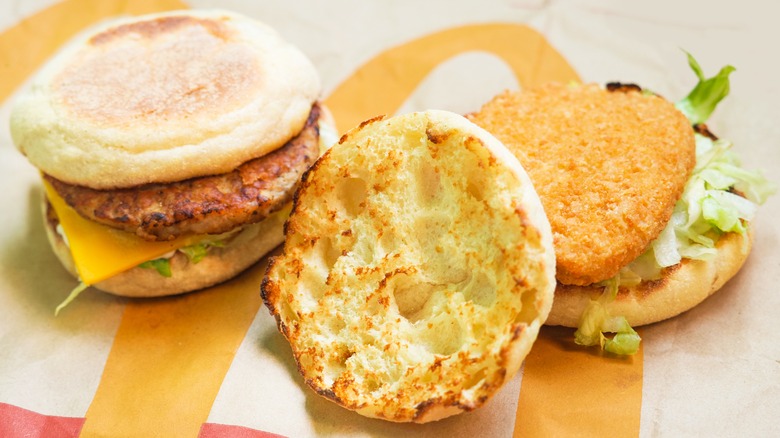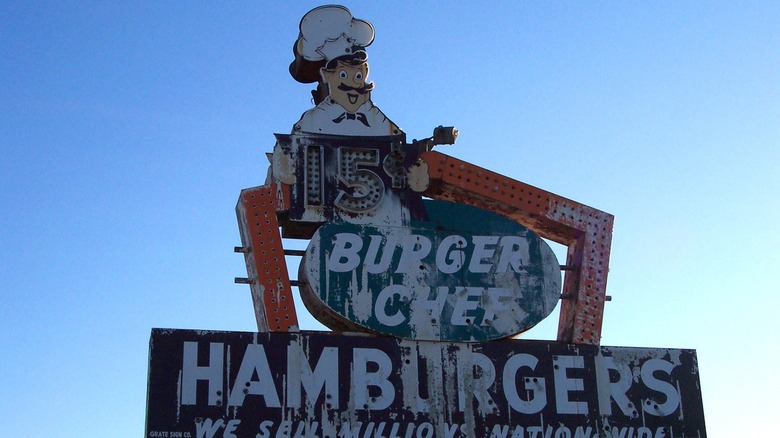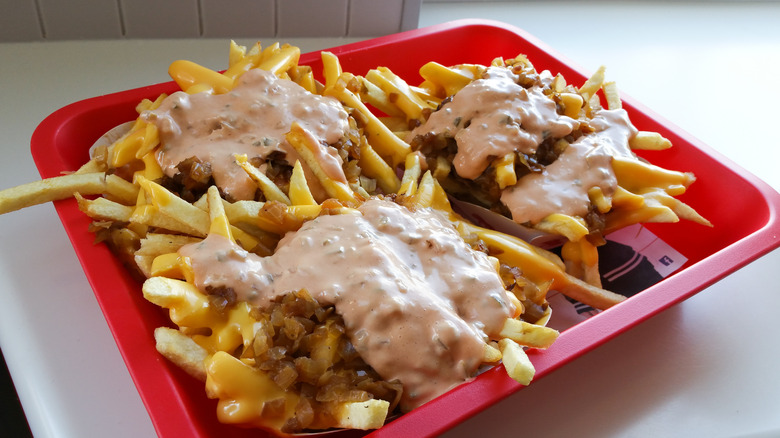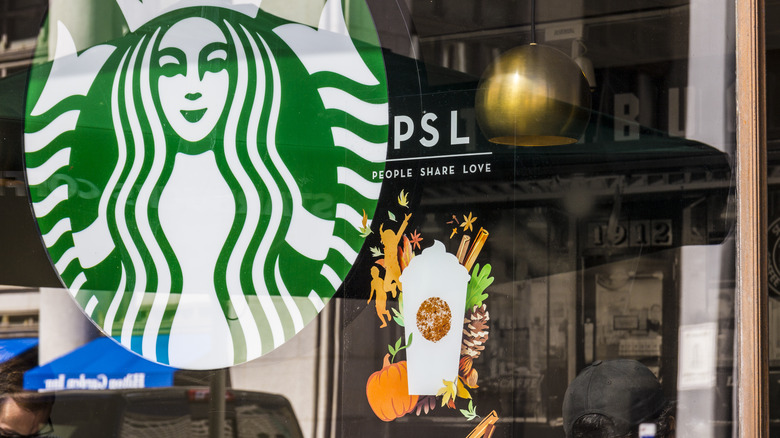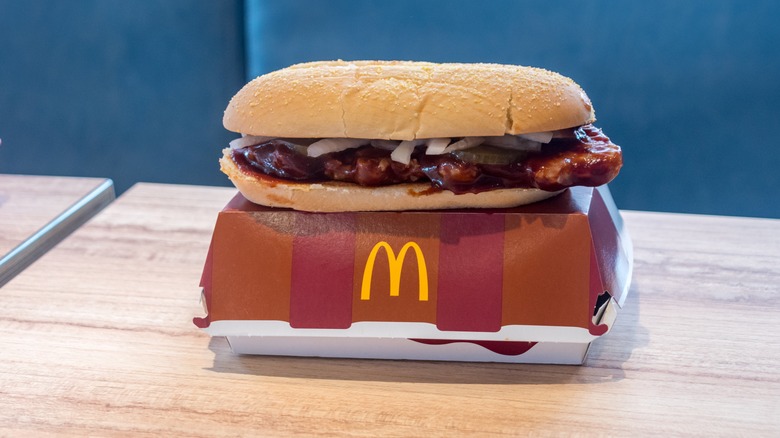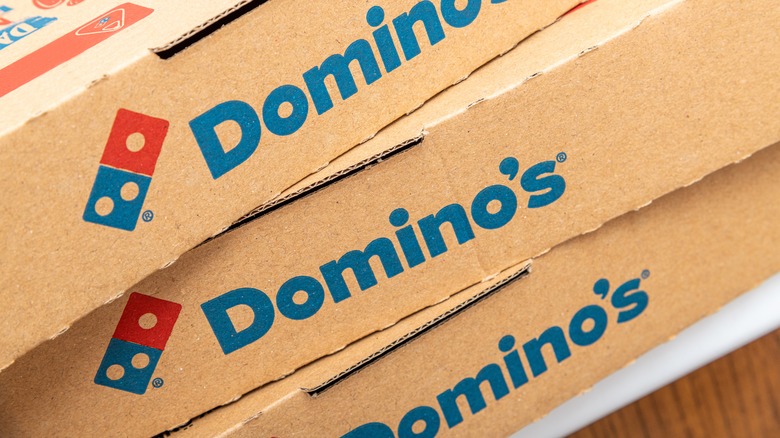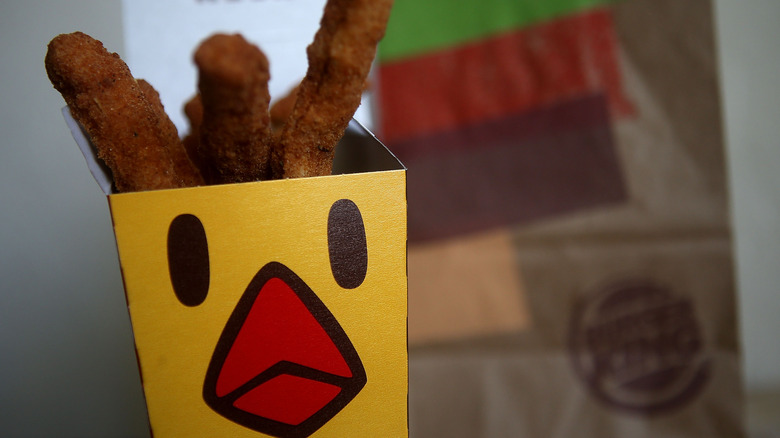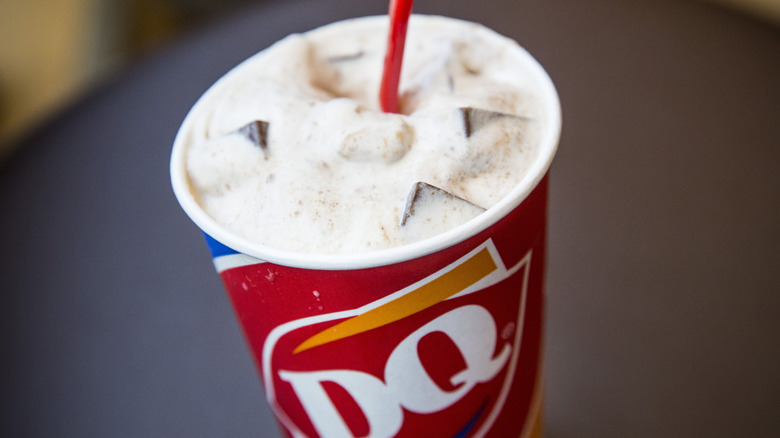Fast Food Menu Items That Changed The Game
The world needs more mavericks. After all, more risk can spell a greater reward. There may be no better place to look towards innovation than fast food, as it's an entire ecosystem built upon getting more flavor into our mouths with less wait time. To that end, fast food restaurants have released countless culinary revolutions, churning out gastronomic earthquakes that shake the very foundations of our expectations ... or some less-impressive ones that might just send us sprinting to the bathroom. These extraordinary creations defy conventions, challenge our taste buds, and sometimes leave us craving more.
The halls of fast food fame are lined with culinary geniuses who thought outside the box or flew too close to the sun, including hilarious mishaps that paved the way for unexpected triumphs. So buckle up as we honor some of the most game-changing things that came out of the greasy kingdom of fast food.
Popeyes' Chicken Sandwich
While Chick-fil-A is almost definitely lying about having invented the fast food chicken sandwich, Popeyes may have perfected it. The chain launched a regular and spicy chicken sandwich in 2019, shifting the balance of fast food poultry power and pitting brother against neighbor in a sandwich struggle for the ages. It's a beautiful sandwich that's the result of years of rigorous experimentation by the chain's Miami-based test chefs. Each slab of breast meat is coated in flour not once, not twice, but a mind-boggling 20 times before it finally takes a dip in the fryer. A generous helping of mayonnaise is the final touch and, if you order it spicy, also features a splash of cayenne pepper.
Those years of preparation came in handy almost immediately. Just a week after Popeyes Chicken Sandwich brought new hope to fast food, Chick-fil-A struck back, subtweeting about similarities between ingredients and asserting its chicken sandwich's primacy. The move backfired spectacularly, pouring oil on the simmering chicken sandwich war and giving Popeye millions of dollars worth of free press and a craze that sold two months' worth of chicken sandwiches in two weeks.
Soon enough, all sorts of fast food chains had no choice but to jump into the chicken sandwich ring. In the 18 months following Popeye's breakthrough, no fewer than 20 new chain chicken sandwiches entered the battle, intensifying the fight for chicken supremacy that continues to this day.
Burger King's Impossible Whopper
Unlike previous vegetarian menu items that satisfied only a niche group who only stepped into a fast food chain when forced to do so, the Impossible Whopper boldly positioned itself as a Whopper without beef. While Burger King's Impossible Whopper doesn't rank amongst the best chain restaurant veggie burgers, its audacious release marked a pivotal moment for vegetarian fast food.
Burgers made with Impossible Foods ingredients had already made appearances at White Castle and select Carl's Jr. locations, and Burger King had even offered a veggie burger on its menu before. However, the Impossible Whopper isn't just another veggie patty. It's a bridge to a world where carnivores and herbivores coexist, bite by beautiful bite. The Impossible Whopper used a new recipe by Impossible Foods that mimics the juciness of real beef and boldlyclaimed that diners couldn't taste the difference.
Burger King released the Impossible Whopper with several campaigns that endorsed the beefy texture and even created a 50/50 menu adventure that invited customers to guess whether or not they just ate meat. The nationwide rollout at more than 7,000 BK restaurants doubled the availability of the sandwich and initiated many conversations surrounding veggie options.
KFC's Double Down
In the 2010s, KFC redefined thinking outside the bun, but not without controversy. Nutritionists wrote letters asking the chain to avoid advertising its notorious Double Down within 500 yards of schools, while The New York Times food critics decried the bun-less sandwich made with chicken, cheese, and bacon. Foreigners asked by The Guardian to try a bite subsequently decided that it felt like "America, in sandwich form." Even Yum! Brands seemed like it could hardly believe it, originally announcing the sandwich on April Fool's Day and marketing the sandwich with the tagline "It's real." In a commercial, a skater ready for lunch confidently declared, "Today, I ignore the voice of reason."
Love it or hate it, the KFC Double Down is one of the most original creations in the history of fast food. This notorious sandwich provoked an equally shocked response from health food avocates it did gleeful gourmandizers – even though KFC's chicken pot pie is arguably way unhealthier.
KFC called this its most hyped test market item in history after is sold 10 million Double Downs in the first month, as people flocked to KFCs out of sheer curiosity. The sandwich never made it to the permanent menu, only popping up when The Colonel is reportedly feeling chaotic.
McDonald's' McMuffin
Drawing inspiration from European bap sandwiches that made the English breakfast mobile, as well as the Denver sandwich (essentially a Denver omelet on white bread) and a similar creation at Jack in the Box, McDonald's introduced its own breakfast marvel in 1971. Intending to convert eggs Benedict into a handheld drive-thru option, a McDonald's employee ingeniously combined a fried egg, melty cheese, and savory Canadian bacon in the soft embrace of an English muffin. McDonald's quickly branded it the McMuffin and road the sunrise sammie to $5 billion in annual revenue.
While most modern fast food chains have since followed suit and created handheld ways to start your day, the McMuffin was controversial at the time, even within the McDonald's corporate circle. Owner Ray Kroc wrote in his autobiography that "it was a crazy idea — a breakfast sandwich," and even admitted that, had he not tried it himself, he would have dismissed the whole thing (via The Washington Post).
Luckily, we don't live in that timeline. With McMuffins leading the charge, McDonald's breakfast swiftly became a juggernaut. The menu item's combination of flavors and convenience captured the hearts and stomachs of hustling breakfast lovers worldwide and forever changed the day's most important meal.
The fun meal
When marketing products to children, a splash of color and a special treat can make all the difference. Convincing fully developed frontal cortexes (that is, adults) to pull into the drive-through may be challenging, but you can nearly always captivate their kids with flashy advertising and let them take care of the rest. Today's fast food industry spends billions marketing to minors, more often than not sending them to a kids meal similar to what the Burger Chef restaurant first cooked up.
This now-defunct fast food pioneer was the first known restaurant to come up with the classic burger, fries, and drink combo. It also revolutionized the industry by dropping toys in bags and calling it the Fun Meal. The chain even teamed up with the "Star Wars" franchise to create mealsw specifically targeting children. The Fun Meal enjoyed a six-year run as one of the only kids' meals around until McDonald's introduced its Happy Meal in 1979. The rest is history.
Ronald McDonald may have stolen the Burger Chef's thunder, but the failed chain will forever rest in the fast food hall of fame for finding a way to get the whole family to stop in. From that point onward, the industry recognized the enormous potential of appealing to young palates, unleashing a wave of whimsical meals and toys that have carved out a permanent home in countless childhood memories.
IN-N-Out's Animal Style
In-N-Out has built a cult following off a menu with only three meal items. Part of the company's success is due to its use of fresh ingredients, including fries cut on the spot, and a lack of in-store microwaves, freezers, or heat lamps. But another huge key to its brand is an epic secret menu spearheaded by something known as "Animal Style." Ordering Animal Style is a flavor-packed way to upgrade your trip to the west coast. It uses mustard, onions, pickles, and In-N-Out sauce to enhance your Double Double or drop a cheesy, oniony, saucy bomb on your fresh-cut french fries.
The special sauce that makes up a successful secret menu seems to be customer service. Company brass at In-N-Out promises that they never workshopped different names or flavor combinations that led to these concoctions. Instead, they claim that they encourage franchises to serve food exactly as the customers desire, and let the clients handle the press. This special order has become an open secret amongst In-N-Out fans and influenced numerous imitations across the fast food landscape.
Regardless of the company's intentions, animal style is a smash hit. It creates a sense of camaraderie among loyal customers, making them feel like part of an inside joke. Other brands have tried to cultivate their own secret menus through press releases or reportedly forcing employees to burn their fingers for quesadilla burritos. However, no one can quite yet replicate the grassroots movement that is Animal Style
Starbucks' Pumpkin Spice Latte
You can throw out the Gregorian calendar. Fall starts when the Pumpkin Spice Latte is back on the Starbucks menu. The flavored coffee drink typically appears at Starbucks locations towards the end of August and gets drinkers through the changing weather with a splash of cinnamon and nutmeg. In 2022, even during a union-busting controversy, Starbucks posted its best week of sales ever in part because of its iconic latte.
The Pumpkin Spice Latte received an essential facelift after 2015 when the chain included real pumpkins in the PSL mix. The Pumpkin Spice Latte has enjoyed a meteoric rise in search interest and caused pumpkin and pumpkin-spiced sales to skyrocket. In 2022 alone, it was estimated that Americans spent over $500 million on pumpkin-spiced products.
It's not necessarily new, as pumpkin pie spice has been marketed to customers since the 1930s, but nobody has gotten it into the hands of more Americans than Starbucks. The rise of the PSL can be credited to a well-crafted social media presence that successfully rebranded pumpkin spice as an autumnal event that landed a spot right next to comfy sweaters in the fall pantheon. Many companies have since followed in Starbucks' seasonal footsteps, but nothing says fall quite like the coffee chain's PSL.
McDonald's' McRib
The McRib, a menu item that has mastered the art of playing hard to get, first bid farewell to the McDonald's menu in 1985. In the decades since, the sandwich has embarked on more farewell tours than KISS. Its second grand adieu happened in 2005 when the rib sandwich said goodbye with a Farewell Tour '05 website.
Yet, the McRib enjoyed three more swan songs over the next three years before spending four years out of the national spotlight. There were regional sightings, while dedicated fans set up McRib trackers and took off on McRoad trips in search of the saucy sandwich. The McRib's delayed release saved Christmas 2012. It has since popped up time and time again, always disappearing just as quickly as it came. McDonald's leans into McRib's transient nature at every opportunity, acknowledging that taking it away and bringing it back sparks interest and playing coy with press releases and social media posts.
While the real reason the McDonald's McRib keeps disappearing is much more than simply drumming up publicity, the marketing campaign behind this sandwich has created a story that may be much better than the McRib itself.
Domino's Pizza's turnaround
Domino's Pizza once spent millions of dollars to tell the world its own food tasted like cardboard. The brand launched a massive advertising campaign that severed ties with the past and promised a better pizza experience in the future. Spearheading the gamechanger was a video that starts with comments alleging microwaved pizza's superiority before cutting to the president of Domino's acknowledging those complaints. Then we meet marketing directors, head chefs, managers, and PR teams, who all read out negative comments that "hit them right in the heart."
The brand had two choices: curl up in a ball and cry, or make a change. So, Domino's started from scratch, scrutinizing every ingredient and throwing garlic on the crust of its new hand-tossed pizza. A follow-up video sent the head chef canvasing to the same focus groups that had just trashed Domino's dough with a fresh take on pizza, ending with the company's new slogan, "Oh yes we did."
At the time, this kind of self-awareness from a fast food chain was shocking. Going vulnerable worked magic. The closing price of Domino's stock on the day the video dropped was hovering around $7.73. By December 2017, the price per share had increased to almost $200. Taking feedback and honestly admitting mistakes had never been more profitable.
Burger King's Chicken Fries
After its debut in 2005, Burger King's Chicken Fries encouraged a cult following of fans who would not let the dream die. There's not much in this world that makes more sense than chicken fries, which came in a dedicated box that included a special slot to hold dipping sauce. You can't just take something like that away from hungry fans. After the fries dropped off the menu in 2012, ravenous chicken dippers started Facebook groups and signed petitions begging the King to bring the fries back.
That grassroots campaign may have been all for naught if it wasn't for a convenient typo. Company bigwigs noticed a spike in chicken fried conversation after One Direction member Liam Payne tweeted that he ate his body weight in the menu item. He had earlier declared his love for "The Kernel" over at KFC, so there is a chance Payne wasn't even eating Chicken Fries from Burger King. But that didn't really matter. The tweet was crucial in bringing Chicken Fries back as a limited-time offering. Dedicated fans took it from there, placing enough orders to convince Burger King to make Chicken Fries a permanent menu item, giving fry enthusiasts eager to prove fast food can be saved by the internet their greatest triumph yet.
Jack in the Box's Monster Burger
On December 28, 1992, Laura Beth Rudolph died after she was diagnosed with hemolytic uremic syndrome. Three more deaths, 171 hospitalizations, and hundreds of recorded infections later, the authorities finally traced the deadly E. coli outbreak back to tainted beef sold at Jack in the Box in the chain's Monster Burger. Anonymous owners of cow-boning plants linked to the outbreak admitted to the Los Angeles Times that, before the outbreak, they didn't even know what E. coli was. The country had previously been blissfully unaware of this bacteria's danger, but this outbreak caught our attention. Fourteen years later, Senator Dick Durbin acknowledged the moment on the Senate floor, calling it a watershed moment in beef history.
Plenty of lawsuits followed the calamity. One particularly damning piece of evidence presented in one suit was an internal memo, dated four months prior to the outbreak, which acknowledged that the chain had been intentionally undercooking hamburgers. Jack in the Box HQ told staff that cooking the patties longer messed up the meat's texture. The resulting court cases bled Jack in the Box of over $50 million and marked a significant turning point in how Americans judged the safety of fast food. The Monster Burger debacle resulted in increased internal temperature requirements, a new labeling system for raw meat, and E. coli testing as part of federal inspections.
DQ's Blizzard
Dairy Queen flipped the fast food milkshake world upside down when it introduced the Blizzard in 1985. The Blizzard carved out a niche by blending toppings, candies, and mix-ins into the creamy concoction, but what really turned heads was the Blizzard's signature move: a sweet mixture so thick you can flip it upside down without spilling a single drop. It checks off all the boxes for a game-changer: a unique schtick and some eye-popping nutrition facts. The new creation became the best-selling ice cream of the summer the very year it was released, instantly shaking up the fast-food dessert world.
In a 1986 interview with The New York Times, Ted Drewes of Ted Drewes Frozen Custard said that he didn't understand the point of adding candy to ice cream. Fast forward to today, and it seems like even he couldn't resist hopping on the mix-in bandwagon, as his namesake stores now offer many different toppings and add-ins like Oreos and M&M's. The Blizzard re-defined soft-serve and remains Dairy Queen's most-ordered menu item to this day.
